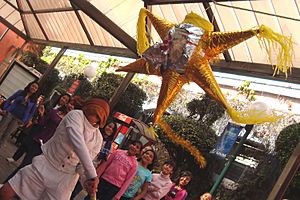Las Posadas facts for kids

Las Posadas is a special nine-day celebration. It is like an extended prayer or devotional event. People celebrate it mainly in Latin America, Mexico, Guatemala, Honduras, and by Hispanic people in the United States. This holiday typically takes place each year from December 16 to December 24. Many Latin American countries still celebrate it with very few changes.
Contents
What Does "Las Posadas" Mean?
The name Las Posadas comes from the Spanish word posada. This word means "lodging" or "a place to stay." It refers to the inn from the story of Jesus' birth. The celebration uses the plural form because it lasts for nine days. This nine-day period is called a novena. It represents the nine months Mary was pregnant with Jesus Christ.
The History of Las Posadas

This celebration has been a Mexican tradition for over 400 years. It began in 1586. Many Mexican holidays include acting out original events. This tradition comes from old Bible plays. These plays were used to teach religious stories to people who could not read in Europe long ago.
In the 16th century, Spanish missionaries brought these plays to Mexico. They used them to teach about Jesus' birth. In Mexico, people already celebrated the winter solstice in December. This was a very important festival. The Aztec calendar honored Tonantzin, the mother of the gods, around this time. Also, their sun god, Huitzilopochtli, was born in December.
The Spanish saw that these native celebrations happened at the same time as Christmas. This made it easy to combine the two holidays. In 1586, a special permission was given by Pope Sixtus V. It allowed Christmas masses to be held throughout Mexico for the nine days before Christmas Day. While its roots are in Catholicism, many Protestant Latinos also follow this tradition today.
How People Celebrate Las Posadas
Two people dress up as Mary and Joseph. Certain houses are chosen to be "inns" for the celebration. The person leading the procession carries a candle inside a paper shade. The actors travel to one house each night for nine nights.
At each house, the people inside respond by singing a song. Then, Mary and Joseph are recognized and allowed to enter. The group of guests comes into the home. They kneel around a Nativity scene to pray, often saying the Rosary. The final celebration might be at a church instead of a home.
People might play the parts of Mary and Joseph. Mary might even ride a real donkey! Others join as angels, shepherds, or pilgrims. Some carry images of Mary and Joseph. Children often carry poinsettias. Musicians follow the procession, and everyone sings special Posadas songs.
At the end of each night, people sing Christmas carols. Children get to break open star-shaped piñatas. These piñatas are traditionally made from clay. After the fun, everyone sits down for a big feast.
Las Posadas in Different Places
The celebration of Las Posadas has some differences depending on where you are.
Las Posadas in the United States
In Portland, Oregon, one event ends with Santa Claus. Christmas gifts are given to children who need them. A large procession has been held since 1966 along the San Antonio River Walk in San Antonio, Texas. It goes past famous places like the Arneson River Theater and the Spanish Governor's Palace. It finishes at the Cathedral of San Fernando.
Las Posadas in the Philippines
In the Philippines, the tradition is called Panunulúyan. Sometimes it is performed just before the Misa de Gallo (Midnight Mass). Other times, it happens on each of the nine nights. The main difference is that actors play Mary and Joseph instead of statues. They sing their requests for a place to stay. The "innkeepers" also often sing their responses. The songs are in a Philippine language, not Spanish.
Las Posadas in Nicaragua
In Nicaragua, older generations celebrated Posadas. However, the tradition became less common in cities by the 1960s. Instead, another big holiday called La Gritería (The Shoutings) is celebrated on December 7. This day honors La Purísima Virgen (The Purest Virgin). La Purísima started in the 1600s and quickly spread. By the 1800s, it became a national holiday.
La Purísima begins at noon on December 7 with many fireworks. Around 6:00 PM, more fireworks announce that it is time. Adults and children go around their neighborhoods with bags. They visit different altars and sing carols to the Virgin Mary. In return for singing, people receive sweets, fruit, and toys. The celebration continues into the night. At midnight, fireworks shaped like Mary, stars, and angels light up the sky.
Las Posadas in Cuba
Cuba has a similar tradition called Parrandas. However, its atmosphere is more like Carnaval. This tradition started in the 19th century. A priest wanted people to go to midnight masses before Christmas. He had the idea to gather groups of children. He gave them jars, plates, and spoons. They would run around the village making noise and singing. This idea grew over the years and became a big street party.
Las Posadas in South America
In Colombia, Venezuela, and Ecuador, families and friends gather from December 16 to 24. They pray the Novena de Aguinaldos.
See also
 In Spanish: Las Posadas para niños
In Spanish: Las Posadas para niños

